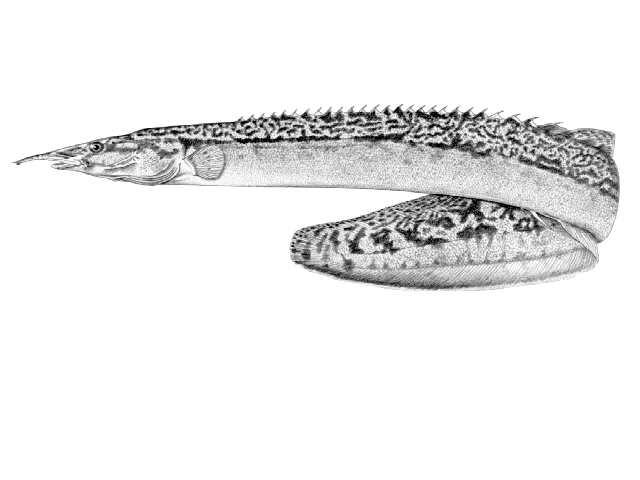|
Dorsal spines (total): 29; Dorsal soft rays (total): 84; Anal soft rays: 80; Vertebrae: 86-88. Diagnosis: 2 strong pre-opercular spines; distance from anterior border of snout to last externally visible dorsal spine relatively long, 57.2% SL; origin of soft dorsal fin about at same height as origin of soft anal fin; postorbital length relatively short, 55.0% HL; 28+1 dorsal spines; 1 strong pre-orbital spine; origin of 1st dorsal spine situated before posterior edge of pectoral fin, (- 2.1)% HL; distance from anterior border of snout to last, externally visible, dorsal spine 57.2% SL, comparable to distance from anterior border of snout to last, externally visible, anal spine, 57.7% SL; post-anal length 49.0% SL, shorter than pre-anal length, 50.4 % SL: 10 caudal fin rays; 6 predorsal vertebrae; 33 abdominal vertebrae; 0 in-between vertebrae; 55 caudal vertebrae (Ref. 57415).
Coloration: uniformly light brown overall background colour; dorsal midline with a series of large, dark brown squared or more X-like spots; upper sides, above lateral line or lateral midline, generally marbled with dark brown irregularly shaped spots; dark brown band originating at base of rostral appendage, passing through eye, above pectoral fin and continuing as a more or less continuous dark brown band, or as a series of large X-like spots along lateral side of body and tail; ventral side of head, belly and abdomen light brown, yellowish-white; dorsal, caudal and anal fins white of overall background colour; dorsal and anal fin base both with a series of dark brown spots partially situated on tail as well; in addition, dorsal and anal fins both with as good as no, or no, additional dark brown spots; pectoral fins white of overall background colour with no, or as good as no, dark brown spots; colour pattern changes with size, notably a general darkening of unpaired fins; in addition, spots on dorsal fin forming several, dark brown, oblique, posteriorly lowering aligned series or bars; dark brown spots on anal fin contacting dark brown band situated towards outer margin of fin resulting in a series of rounded, white spots at anal fin base; nevertheless, unpaired fins retain their white outermost margin; tendency to lose lateral series of X-like spots with increasing size; first, lower arms of X-like spots, situated below lateral line or lateral midline of body, start to fade and gradually completely disappear resulting in more uniformly light brown-coloured lower sides; further, with increasing size, upper arms of X-like spots become less well contrasted with marbled upper sides of body and tail; finally, in the largest specimens, X-like spots are as good as not, or not discernable anymore resulting in a far more uniform dark brown colour pattern of body and tail (Ref. 57415). |

